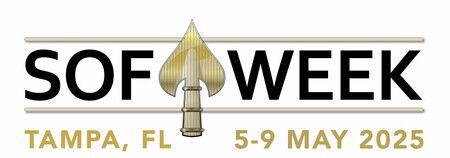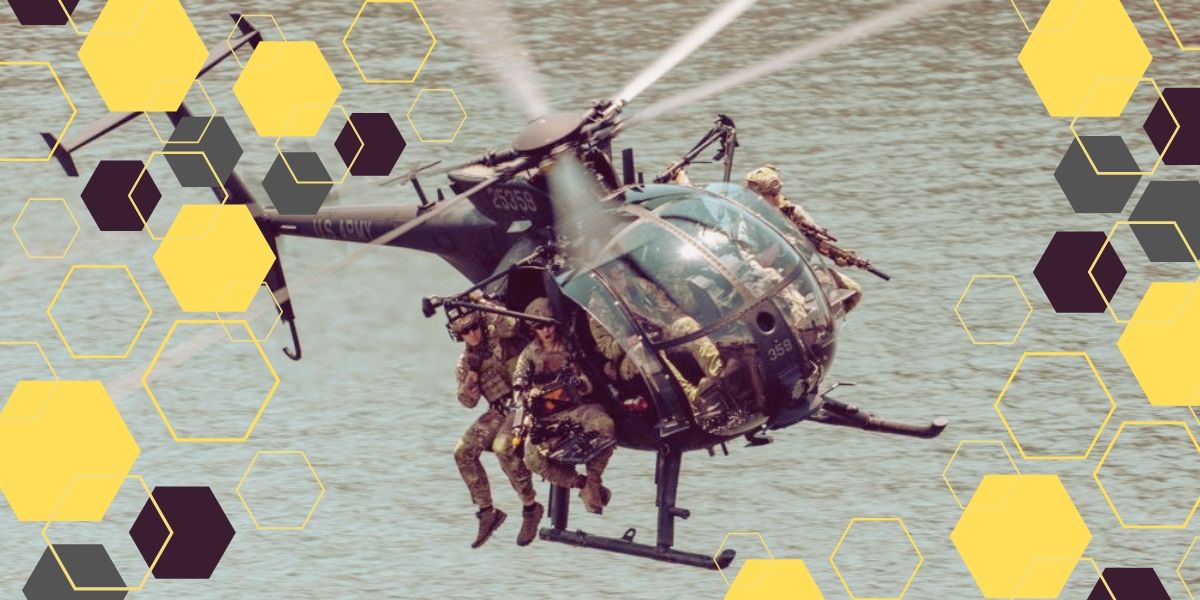STRATEGIC ENGAGEMENT:
Strategic Engagement strengthened and developed relationships with DOD and DOE laboratories, Federally Funded Research and Development Centers (FFRDCs), University Affiliated Research Centers (UARCs), academia, and industry leveraging and influencing larger efforts supporting USSOCOM S&T priorities. Strategic Engagement’s processes seek to uncover new technologies, limit redundancies, gain efficiencies, and synchronize long range future planning enabling SOF to maintain the operational advantage.
FUTURES:
S&T Futures executed three Innovation Foundry (design thinking) and three Rapid Capability Assessment (RCA) (capability decomposition) events. The outputs of the RCAs culminated in one Integrated Tech Sprint Demonstration in October 2023. These events enabled the development of disruptive capabilities in artificial intelligence (AI), man-machine teaming, communications, and next-generation effects. All events paired SOF Warfighters with non-traditional engineers and scientists in government, industry, and academia across the U.S. to identify potential opportunities for disruption and overmatch. Concept Capability Packages, white papers, experimental prototypes, and videos are available for key stakeholders.
CAPABILITY FOCUS AREAS (CFAs):
Biotechnologies/Human Performance
Completed multi-year development efforts for the creation of coagulation fluids combatting hemorrhaging and ReBlast-2, a high-fidelity imaging effort correlating blast exposure and measurable physiological changes in the brain.
Continued focused efforts on optimizing brain health by mitigating posttraumatic stress disorder, limiting impacts of blast exposure in SOF, optimizing operator nutrition and stress, and an intranasal treatment for mild traumatic brain injury.
The USSOCOM Surgeon’s Office in conjunction with S&T conducted a Medical Simulation training Technical Experimentation (TE) event at the University of South Florida, Center for Advanced Medical Learning and Simulation in Tampa from 6-10 February 2023. The event produced a comprehensive report to assist with identifying best practices in medical training, the use of simulators, AR\VR technologies, and potentially guide future SOF medical training requirements development.
Next Generation ISR & Tactically Relevant Situational Awareness (ISR/SA)
Continued to advance ISR/SA systems across all domains air, ground, maritime, cyber and space advantage. FY23 efforts worked to develop and refine advances in technology areas of Machine Learning (ML) within the AI domain for detection, recognition, and identification. Additionally, augmented Reality demonstrations from mobile sensors of Heads-Up Display headsets integrating multiple sensors and data sets, multiple communications efforts, and multi-sensor data fusion projects for mapping purposes.
Efforts starting in FY23 included improving CBRNE threat detection with prototype development for automating analytics acting on sensor, contextual, and intel data sources providing a holistic threat detection of CBRNE threats. Additional improvements were made in prototyping AI-enabled data management software to ingest, store, analyze and disseminate ISR and targeting data horizontally within a team or vertically to higher echelons and national agencies.
Efforts completing in FY23 with planned transitions in FY24 include work on compact wide band antennas and remote audio servers. The radio frequency convergence differential segmented aperture development program was a four-year effort developing a compact wide band antenna replacement for multiple narrow band antennas improving SOF operations in contested environments. The SOLVENT effort was a three-year effort developing a remote over the horizon audio server for real-time monitoring, data storage, and analysis of tactical audio collection sensors. This effort enables SOF forces to maintain a persistent and global ground surveillance capability in multiple areas of interest.
Network and Data Management (NDM)
Supported the Commander, AE, and S&T Director RDT&E priorities for contested communications, cyber operations, and alternative navigation technologies. NDM incorporated AI/ML and edge computing technologies in support of these objectives.
Awarded four new contracts to address USSOCOM RDT&E priorities and SOF technology opportunities. One contract included a new Congressional Plus Ups addressing global and SOF data analytics.
Engaged with private industry, UARCs, DOE National Laboratories, and DOD Research Laboratories in 12 on-going projects.
Developed an internship supporting research and understanding USSOCOM interest areas such as large language models. New collaborations include DHS, U.S. Army Combat Capabilities Development Command, and U.S. Army Aviation & Missile Center.
Next Generation Effects (NGE)/Precision Strike
Transitioned to focus on the future fight and pacing challenge. NGE directed this year’s attention on non-kinetic effects of MISO, EW, Directed Energy, and Offensive Cyber Operations.
Maintained multiple precision strike projects. With most of the kinetic efforts entering the closeout phase, it presented the opportunity to refocus the effects meeting Command prioritization. Eight new non-kinetic projects introduced because of this new direction.
Next Generation Mobility
Continued multiple signature management efforts aimed at reduction of acoustic, visual, infrared/thermal, and electromagnetic signatures of various SOF systems.
Increased focus on digital signature management assisting the SOF Warfighter operate in a world of ubiquitous technical surveillance.
Funded MITRE to complete a study investigating digital signature management and its effects on the SOF Warfighter. This study will be used to guide future developmental efforts in this area.
Awarded new efforts to Notch, Inc, to develop a signature management shield for use by the dismounted soldier and to Jetpack Aviation to develop a small vertical takeoff and landing UAS for unmanned logistics delivery and future manned mobility.
JOINT ACQUISITION TASK FORCE (JATF), HYPER ENABLED OPERATOR (HEO):
The JATF develops, advances, and integrates technologies significantly improving the quality and speed of SOF Operator decision making at the edge. HEO’s goal is achieving situational understanding and decision-making dominance across multiple domains, gaining and maintaining the initiative. The JATF core development areas are Sensing and Edge Compute, Architecture and Analysis, and Language Translation.
Language Translation-JATF, with mission partners, advanced a Voice-to-Voice (V2V) language translation device for core, high data languages disconnected from the cloud. JATF successfully demonstrated Russian, Chinese Mandarin, and Ukrainian languages, developed a lower profile system, and sparked interest from DOD entities outside of USSOCOM. JATF, with mission partners, spun-off a visual environment translation technology from the V2V.
JATF, with mission partners, initiated the development of a computer vision analytics tool for translating writing found in full motion video and pictures. The intent is to integrate this into the V2V system-of-systems.
Selected a vehicle surveillance detection solution to provide SOF Warfighters awareness of vehicular surveillance using vendor loan agreements and the subsequent purchase of 10 Vehicle Recognition Module prototypes from Percipient.AI.
The prototypes have been shared with four SOF Components to utilize in three AORs for further refinement and analysis.
JATF, along with 7th SFG(A), DEVCOM, and in coordination with local authorities conducted Project Empire 23 in Lower Manhattan, New York City and Eglin AFB, FL. This was the second iteration of this testing event in NYC with the purpose of employing SOF Operators in field testing emerging JATF technologies in a dense urban environment saturated with signals.
TE:
Conducted four TE events focused on S&T capability focus areas, medical training, special reconnaissance, and information advantage/information dominance. These events featured a combined total of 201 experiments and demonstrations. Over 1,280 personnel from USSOCOM, other Services, other Government agencies, and FVEY partners attended these events expanding Command technology domain awareness, while SOF SME assessments informed industry participant design and business planning activities.
SMALL BUSINESS INNOVATION RESEARCH/ SMALL BUSINESS TECHNOLOGY TRANSFER (SBIR/STTR):
In FY23 the SBIR team awarded 33 SBIR/STTR contracts totaling almost $26 million. Utilizing the existing Partnership Intermediary Agreement (PIA) with DEFENSEWERX (local entity SOFWERX) the team awarded $24.7M ($20M in SBIR funding and $4.7M in non-SBIR funding), a nearly 50% increase over FY22. There were 27 individual PIA contract awards supporting 14 SBIR topics, evenly split between Phase I and II.
FY23 USSOCOM SBIR/STTR projects were funded by DOD, Navy, Missile Defense Agency, and Space Development Agency. Technology focus areas included AI/ML enabled Mission Command, maritime/undersea energy storage, microchip development, low-light sensors, autonomous weather sensors, and satellite communications.
Defense Innovation Accelerator (DIA) Concepts and Capabilities (C&C) and Rapid Defense Experimentation Reserve (RDER) (includes the formerly designated Emerging Capability & Prototyping - Joint Capability Technology Demonstration program):
Supported initiation and execution of the first year of a 2-year USSOCOM sponsored DIA C&C project culminating in FY24. USSOCOM will monitor several FY24 approved projects of interest to SOF stakeholders.
Initiated planning activities for two USSOCOM sponsored FY24 RDER projects and coordinated the development and submission of FY25 RDER projects, resulting in one USSOCOM sponsored project scheduled for final review and approval.


.jpg)